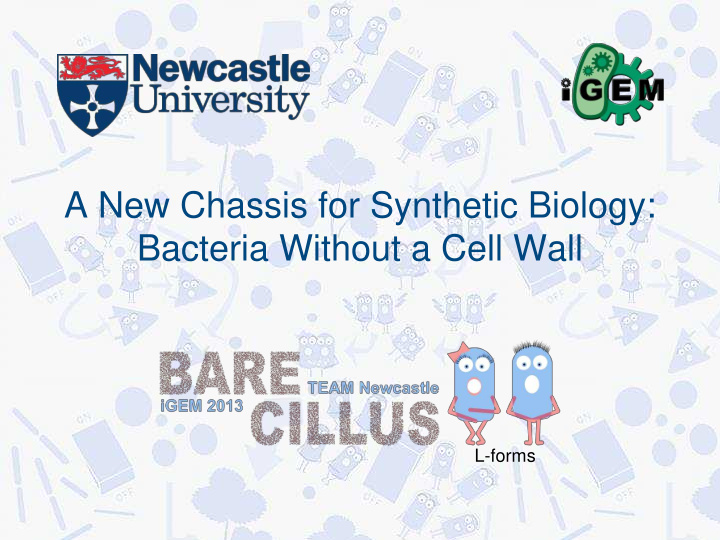



A New Chassis for Synthetic Biology: Bacteria Without a Cell Wall L-forms
Pros & Cons of Cell Wall Cell membrane Cell wall DNA Cell membrane ribosomes RNA metabolites Bacterium with Bacterium cell wall without cell wall
Previous work on L-forms • Discovered by Lister Institute in 1935 • Roles in diseases such as sarcoidosis and septicemia • Pathogens are not a good chassis for synthetic biology • We engineered the non-pathogen B. subtilis to produce L-forms • Built on pioneering work by Prof. Jeff Errington and colleagues at Newcastle TEM pictures of L-forms Gilpin, R. W., Young, F. E. & Chatterjee, A. N., 1973. Characterization of a Stable L-form of Bacillus subtilis 168. Journal of Bacteriology, 113(1), pp. 486-499.
Bacillus subtilis • • • • •
Aim To develop L-forms as a chassis for the synthetic biology community
Synthetic Biology: Engineering Life Cycle Requirements Requirements Refinement Design Maintenance Implementation Verification
Ultimate Goals • Develop a switch device that will selectively turn the cell wall ON and OFF • Demonstrate the use of L-forms for real world applications
Human Practice & Implications QUESTION: Are fused cell-wall less bacteria genetically modified? Implications of release of L-forms into the environment
UK, EU and US Law
Built-in Kill Switch L-forms in soil after 1 min incubation L-forms in normal media NB/MSM 1sec = 1sec
Synthetic Biology: Engineering Life Cycle Requirements Design Refinement Design Maintenance Implementation Verification
Rule-based Modelling From writer’s perspective Standard modelling (eg, Rule-based modelling SBML) (BioNetGen) 39 species 5 molecular types 184 reactions 6 rules
Model-based Design
Switch BioBrick: Modelling Informs Design Peptidoglycan biosynthesis in the absence of xylose Molecule numbers Molecule numbers Molecule numbers
Synthetic Biology: Engineering Life Cycle Requirements Implementation Refinement Design Maintenance Implementation Verification
Switch BioBrick: Implementation BBa_K1185000 pbpb spoVD murE murE pbpB Host chromosome
Synthetic Biology: Engineering Life Cycle Requirements Verification Refinement Design Maintenance Implementation Verification
Switch BioBrick: Characterisation 0.8% (w/v) 0.8% (w/v) xylose xylose 0.5% (w/v) 0.5% (w/v) xylose xylose No xylose
Switch BioBrick in Action 1sec = 7hours B. subtilis L-form expressing GFP B. subtilis rod expressing GFP
Potential Applications
Our Applications
Genome Shuffling
Genome Shuffling BBa_K1185001 HBsu-GFP BBa_K1185002 HBsu-RFP
Implementing Cell Fusion • • • •
Genome Shuffling + L-forms with both HBsu- L-forms with HBsu-GFP L-forms with both HBsu-GFP L-forms with Hbsu-RFP GFP and RFP tagged tagged and RFP tagged tagged
L-forms and plants
L-forms Colonise Plants Brassica pekinensis with Hbsu-GFP tagged L- Brassica pekinensis non-innoculated negative forms around the cell wall control
Human Practices: Revisited
Community Interaction Leeds 2013 iGEM team model using BioNetGen
Summary • • • •
Our BioBricks BBa_K1185000: Enables B. subtilis to switch between a cell walled rod form and cell wall removed L-form, dependent on the presence of xylose in growth media BBa_K1185001: Non-discriminately tags DNA, allowing location of the DNA by glowing green under fluorescence. BBa_K1185002: Non-discriminately tags DNA, allowing location of the DNA by glowing red under fluorescence.
Acknowledgments Dr. Stach Dr. Hallinan Prof. Wipat Dr. Zuliani Dr. Smith Dr. Robertson Ms. Shapiro Mr. Park Dr. Wu Mr. Gilfellon
Summary • A foundational advance : A new chassis for Synthetic Biology; informed by discussion with ethicists and the public • We have created a genetic switch to turn the cell wall on and off • We demonstrated that our engineered L-forms can be fused to shuffle their genomes • We showed that these L-forms can inhabit plants
Architecture Synthethic Biology cycle Architecture cycle
Recommend
More recommend